TENEMENT HOUSE AT UL. WÓLCZAŃSKA 4 IN ŁÓDŹ
We invite you to choose our townhouse as a comfortable and well-located place to stay during your visit to Lodz. Both at the booking stage and during your stay, we encourage you to read the history of the townhouse and its surroundings, as well as a description of its architecture. A rich array of contemporary and original decorations and their connections to the world of flora and fauna await discovery. We believe that when you decide to visit our tenement with the description prepared especially for this occasion in hand, many admirable, delightful details will be revealed to you.
The courtyard of the tenement has been transformed into a garden, where a magnificent two-meter-high rhododendron reigns among many evergreen plants, The courtyard space is illuminated by a unique stained-glass lantern with a representation of a lavender meadow populated by colorful butterflies. It is from the green courtyard that one can most easily view the set of a dozen or so contemporary stained glass windows filling the windows of the building’s staircases. They present the most beautiful butterflies found in Poland, whose photos and descriptions we have included in the gallery below.
STREET HISTORY
Wólczanska Street is inscribed in the history of Lodz. It used to be a street of factories, palaces, villas and townhouses. Its origins date back to 1825, when this street was separated from the village of Wólka. During the period of the city’s development, Lodz factory owners Kindermann, Lange, Richter, Huffer and the Schweikert brothers built their residences along it. During World War II, the street lost many buildings, including in November 1939 the beautiful synagogue then located at number 6 (and thus on the plot next to the Wólczańska 4 development). The synagogue was colloquially known as the synagogue of “Litvaks” – Jews arriving in 1891-1892 and 1905-1907 to the Kingdom of Poland from the Russian settlement zone, mainly from the western governorates – the current territories of Lithuania and northern Belarus. Today the former synagogue site is occupied by a parking lot and a private school building.
Construction of the six-story tenement house at 4 Wólczańska Street began in 1913, and it was put into use a year later. The tenement was built on a roughly rectangular plan and consists of a front building, two side outbuildings and a closing transverse outbuilding. The building is an excellent example of late 19th and early 20th century residential architecture.
ARCHITECTURE
The tall, four-story building with a usable attic represents the “well” form characteristic of tenement houses – the front and outbuildings closely enclose the courtyard on four sides. The front elevation, facing Wólczańska Street, has gained the richest form. The base of the building was distinguished by strip rustication. The overlight above the entrance door was developed in a decorative way. We are talking about a round opening, framed in a profiled band, through which light enters the corridor, illuminating the path leading to the staircase. It is here that the first of a series of stained glass windows, a hallmark of the building, awaits guests. A contemporary, colorful glazing with a butterfly motif – the peacock russet – is set into the metal frame of the overlight.
The floors forming the development of the building were rhythmized with strips of white veneer – a small ceramic tile, forming distinctive, narrow, bright rectangles on the facade. This part of the building has preserved the most detail. It is worth noting the decorative under-window panels. These are strips of ornaments composed on a rectangular plan, emphasizing the position of windows on the facade. Among the motifs used, one can observe stylized acanthus leaves, picturesquely curved escutcheons, geometric “breakers” of meanders, as well as strips of a cubic cornice closing this part of the facade. The top of the building is varied with two gables with a concave-convex arch line. Such a solution creates a sense of monumentalism, softened, however, by the soft line of the forms used.
TENEMENT HOUSE ELEVATIONS

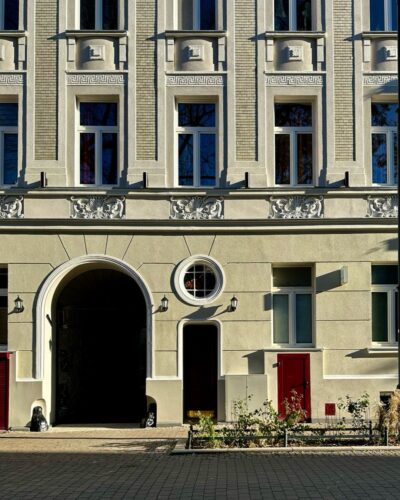



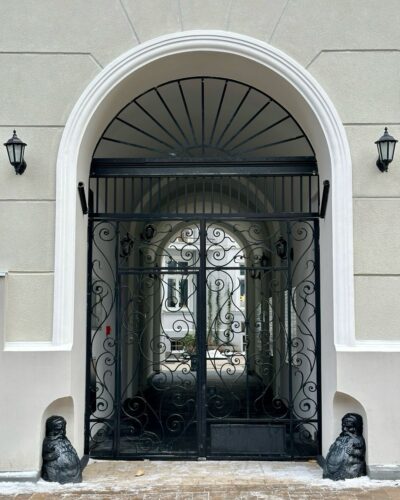
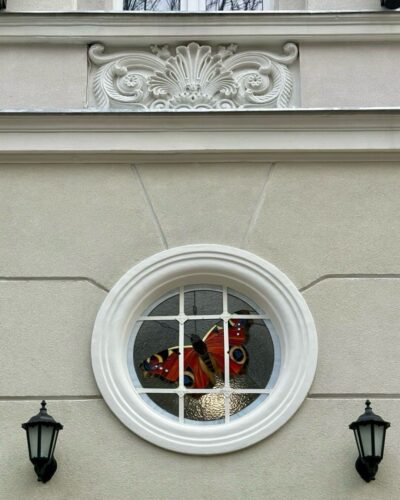



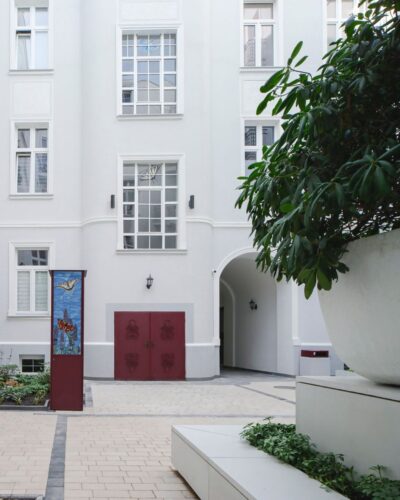



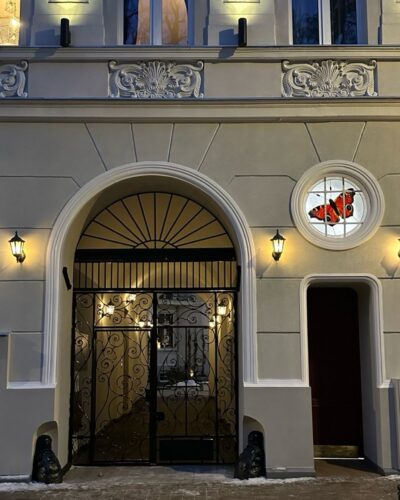
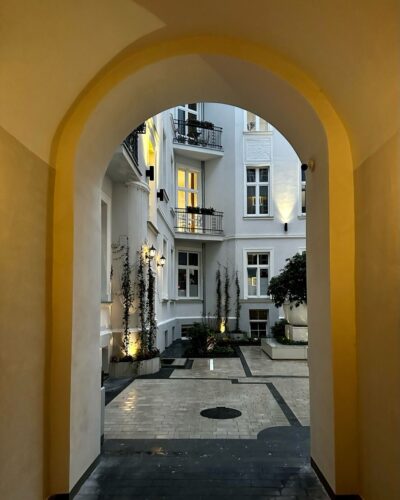


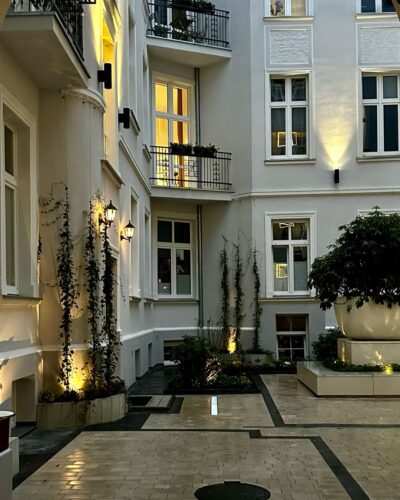












































STAINED GLASS
Łódź is famous for its numerous examples of sophisticated artistic glazing, which can be admired in both secular and sacred buildings. In reference to and in tribute to this unique heritage, we decided to expand the suit of Łódź stained-glass windows with more than a dozen contemporary realizations. The leitmotif is the world of nature, on the one hand perfectly corresponding with the historic architectural fabric of the tenement and the city, and on the other hand, fitting in with contemporary trends. Significantly for our mission, the glazing was made by the efforts of local stained glass artist Ms. Kamila Bieni-Borowska. As a result, the windows of the staircases of the tenements gained multicolored, and in part also textured glazing, depicting the most beautiful Polish butterflies.

European peacock(Aglais io)
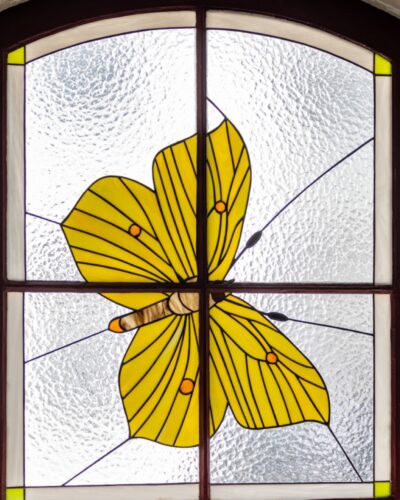
Common brimstone(Gonepteryx rhamni)

Scarce swallowtail(Iphiclides podalirius)
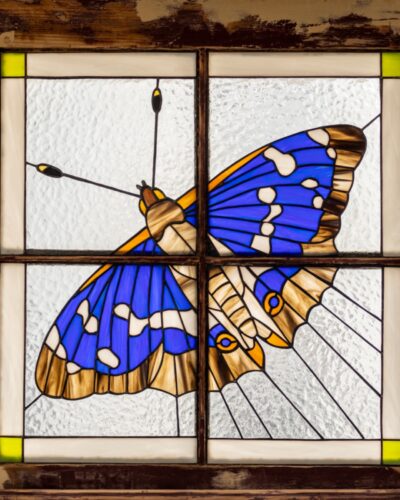
Purple emperor(Apatura iris)

Orange tip(Anthocharis cardamines)
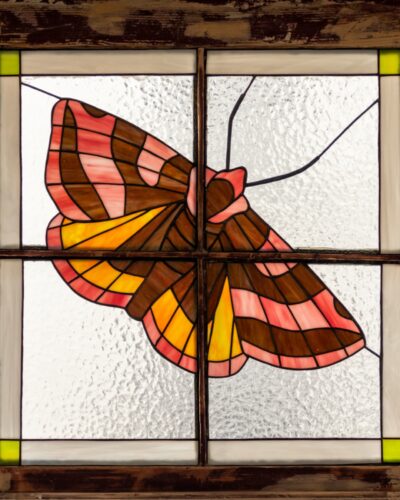
(Lythria cruentaria)
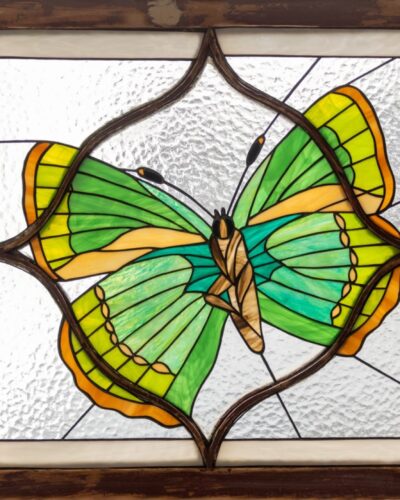
Green hairstreak(Callophrys rubi)

Cinnabar moth(Tyria jacobaeae)

Holly blue(Celastrina argiolus)
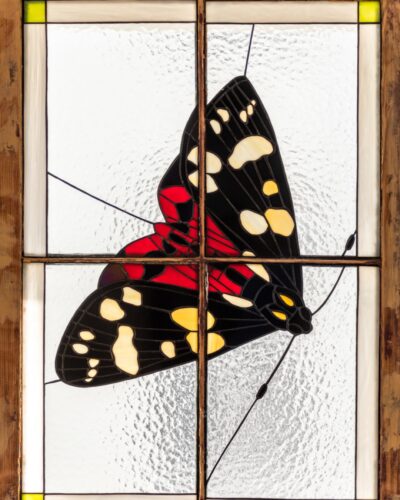
scarlet tiger
(Callimorpha dominula)
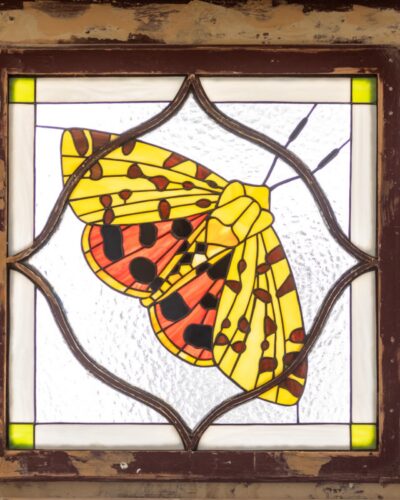
Niedźwiedziówka purpurka(Diacrisia purpurata)

Czerwończyk fioletek(Lycaena helle)

Słupek na patio

Irysy

European peacock(Aglais io)

Common brimstone(Gonepteryx rhamni)

Scarce swallowtail(Iphiclides podalirius)

Purple emperor(Apatura iris)

Orange tip(Anthocharis cardamines)

(Lythria cruentaria)

Green hairstreak(Callophrys rubi)

Cinnabar moth(Tyria jacobaeae)

Holly blue(Celastrina argiolus)

scarlet tiger
(Callimorpha dominula)

Niedźwiedziówka purpurka(Diacrisia purpurata)

Czerwończyk fioletek(Lycaena helle)

Słupek na patio

Irysy

European peacock(Aglais io)

Common brimstone(Gonepteryx rhamni)

Scarce swallowtail(Iphiclides podalirius)

Purple emperor(Apatura iris)

Orange tip(Anthocharis cardamines)

(Lythria cruentaria)

Green hairstreak(Callophrys rubi)

Cinnabar moth(Tyria jacobaeae)

Holly blue(Celastrina argiolus)

scarlet tiger
(Callimorpha dominula)

Niedźwiedziówka purpurka(Diacrisia purpurata)

Czerwończyk fioletek(Lycaena helle)

Słupek na patio

Irysy
The european peacock was not accidentally referred to as "peacock" - the multicolored spots on its wings are arranged in characteristic eyes, similar to those on the tail of a peacock. The English also recognized this, calling the insect a "peacock butterfly." Even more interesting is the Latin name. "Aglais" means "Radiant" - one of the three Greek Charites, or Roman Graces. The sisters symbolized playfulness, grace and joy, and patronized the arts, crafts and particularly lovely young people. Io, on the other hand, was the name of a nymph and lover of Zeus, on whom his wife, Hera, took severe revenge. Although the name of this quite large butterfly (up to 60 mm wingspan) is due to its beauty, the rainbow eyes are not at all a mere decoration. When frightened or attacked, the european peacock with a loud rustling spreads its folded at rest wings - the attacker is startled by the sight of large, staring eyes. Sometimes such a run saves a butterfly's life.
The common brimstone is one of the most popular Polish butterflies, found in early spring and often taken as its harbinger. The color of its wings is associated with the sun warming the frozen ground, but only in the case of males. Females are celadon in color, although even in them four orange spots on the wings, characteristic of this species, can be seen. As the only butterflies in Europe, common brimstones are able to survive the winter. When the temperature drops, they hide in dried leaves lying under a layer of snow. This allows them to wait until spring, which - along with autumn - is the period of their greatest activity. In summer, they fall into summer sleep, called estivation - thanks to the slowing down of vital processes, they can survive the heat, which does not serve them. Common brimstones live to an unusually old age, measured by the measure of butterflies. Under favorable circumstances, they can survive the entire year, which sometimes allows them to meet their offspring, which pupate into adult butterflies in July.
The scarce swallowtail is distinguished not only by its rich, contrasting colors, but also by the characteristic "swallow tails" on the ends of its lower wings. It is to these that it owes its English name - "swallow tail," which literally means "swallow tail." If that weren't enough, its Latin name is also significant. It refers to two figures of Greek mythology - Iphikles, the brother and companion of Heracles' many expeditions, and Podalejrios - the healer, suitor of Helen, and participant in the Trojan War. Heros is most appropriate here - after all, the scarlet is one of the largest Polish butterflies, with a wingspan of up to 80 mm. We usually admire butterflies for the beauty of their wings when they reach adulthood. In the case of the claw, it's also worth looking at the caterpillars and pupae - after all, their lives depend on the art of camouflage! The caterpillars, initially black and white, then green, change to a mustard color with age, resembling bird droppings.
The purple emperor owes its unconventional names - both Polish, Latin and English - to the shimmering purple spots on the top of its wings. Because of these, the British refer to the butterfly as the "purple emperor." Even more interesting is its Latin name, which includes two references to antiquity - "Iris" refers to the Greek goddess of the rainbow, while "apaturia," meaning "deceptive," is one of the many nicknames for Venus, the goddess of love and beauty. Despite the pleasant mythological connotations, swordtails have very unusual habits that can make you shudder. They do not consume nectar from flowers, as most diurnal butterflies do. Instead, they prefer to suck the sap from wounded trees, draw mineral salts from decaying tissues and secretions (including carrion and feces), and they don't disdain honeydew, extracted from aphids.
The males of the orange tips - one of the most common Polish butterflies - can be spotted from a distance because of the characteristic bright orange spot on the wing. Females have an almost white top of the wings, while their underside - as in males - is covered with a pattern similar to military moro. The name of the species is not coincidental - the green-blue caterpillars of the aurora like to feed on cress, and will not disdain garlic or horseradish. However, when they have to compete for food, cannibalism often occurs between them. Interestingly, adult butterflies feed on the nectar of those plants they ate earlier in life. Orange tips pupas are true masters of camouflage - they change their color along with the seasons, trying to fully resemble the colors of the plant on which they will spend almost a year. The transformation continues through three seasons, including winter - adult butterflies can be seen as late as mid-April.
What are the characteristics of nocturnal butterflies, or moths? The first thing that comes to mind is the nocturnal lifestyle and the sparingly pale colors. Scientists also note that diurnal butterflies usually have straight feelers, sometimes ending in a thickening called a roll, and rest by folding their wings vertically upward. Moths often have feathery feelers, resembling palm leaves, and fold their wings on the sides of their bodies, or one over the other, like tiles. But do these rules always apply? No - and a perfect example of this is the sorrel sudamek. The sudamek is a small moth with exceptionally beautiful wings, in highly saturated colors of yellows and purples. They can reach a span of up to 23 mm. Although assigned to nocturnal butterflies, it is active during the day. It is most likely to settle in dry places such as wastelands, baulks and forest edges. Its mottled caterpillars feed primarily on sorrel leaves, which is where its name comes from. Up to three generations of sudams can be born in a single year.
Green butterflies are among the smallest Polish butterflies, with a wingspan of up to 25 mm. They are unique - they are the only domestic species to have wings in a shade of sea green, with a beautiful metallic sheen. However, this color covers only the underside of the wings, visible when the butterflies sit motionless; the top of the wings is brown. Green butterfly pupae are true ant charmers. They attract these small insects with sounds similar to the ticking of a watch, audible to humans as well. They then feed the ants with a sweet secretion similar to honeydew. As a result, they are recognized as a valuable find and carried to one of the safest places in the insect world - deep inside the anthill. Few creatures threatening the greenfly pupae will be able to defeat half a million ant bodyguards. However, parting can be difficult - ants often take the adult butterfly as an intruder, so as soon as the greenfly sheds its pupa armor, it must flee.
Cinnabar moth - despite its not very impressive size (up to 40 mm wingspan) - is eye-catching from a distance. This is all due to the contrasting color scheme - graphite wings have distinctive red accents. The English associated their color with cinnabar - a mineral made from mercury sulfide, which was rubbed off into the orange-red pigment of the same name. It's not just the proporice's wings that are hard to miss. The caterpillars of this species are covered with yellow and black stripes. This is not a coincidence, but a warning - the insect at this stage of development is poisonous to most birds and invertebrates. Proporice caterpillars like to feed together, which poses a great threat to host plants. In the course of evolution, they have developed an unusual response - they reduce the toxicity of their leaves, encouraging aphids to feed. They are followed by ants attracted by honeydew, which are dangerous to the caterpillars. This is already too much for the proporice - it gives up feasting at the communal table.
Holly blues , as the name suggests, are blue butterflies. Their wingspan reaches 30 mm, so they are rather small. At first glance, it is possible to distinguish the female from the male - ladies of the holly blues have a characteristic black band on their wings and a row of tiny dots of this color. Holly blues caterpillars are polyphagous, which means that they are not picky about nature's canteen - they can feed on a variety of plants. If they have a choice, they are most likely to eat flowers and fruits, but when circumstances are not favorable - they can also feed on leaves. They adapt their coloration to the menu - they can be green, pink or even red, as long as they feed on such flowers. Both caterpillars and pupae of the holly blues have learned to cooperate with ants. The army of these tiny insects is a terror in the insect world, hence it is better to have them on your side. Butterflies achieve this by producing a sweet substance that ants are fond of. No wonder, then, that they try to protect their living larder in various ways.
Krasnopani poziomkówka z daleka zwraca na siebie uwagę charakterystycznym ubarwieniem skrzydeł. Przednie są czarne z żółtymi i białymi plamkami oraz zielono-niebieskim połyskiem, tylne - szkarłatne z akcentami czerni. Te nocne motyle, żyjące za dnia, często można spotkać w otoczeniu poziomek – stąd wzięła się ich polska nazwa. Anglicy postanowili dodać owadowi nieco majestatu, nazywając go „szkarłatnym tygrysem”. Dochodząca do 55 mm rozpiętości skrzydeł ćma wyróżnia się także czułkami. Nie są one proste, ale wygięte do tyłu na kształt łuku. Gąsienice tego gatunku początkowo są czarne, jednak z wiekiem nabierają koloru. Na ich ciałach pojawiają się kępki jasnych włosków oraz białe i żółte plamki. Najchętniej żerują nocą, w dzień ukrywając się pod liśćmi.
Without a doubt, the purple tiger is one of the most beautiful Polish moths. The front pair of wings is kept in beige-coffee tones, while the back pair is a contrasting combination of red and black. The Polish name refers both to the color scheme and to the subfamily of bear moths, to which the moth belongs. The English also relied on the world of large predators in creating the name, but chose the tiger instead of the bear; this nocturnal butterfly is called the "purple tiger" in the British Isles. Perhaps the choice of the British is also dictated by the form of the caterpillar. Its black and yellow body is overgrown with dense rusty-white bristles, making it similar in color to a tiger. Interestingly, during the successive phases of life the insect changes its habits - as a caterpillar it likes to bask in the sun, as an adult moth it chooses nocturnal times of activity.
The violet copper owes its name to the distinctive purple sheen on its black and chocolate wings. The color scheme is complemented by white and orange accents, making them among the of the most beautiful butterflies found in Poland. Despite its small size (23-28 mm wingspan), the violet copper is distinguished by its warlike disposition - the males of this species aggressively defend their territory, often chasing away from it not only rivals of their own species, but also other insects. They also do not hesitate to accost much larger than themselves! Male and female scarabs differ in color - which in the world of butterflies is not surprising. Few people know, however, that by the colors of their wings you can also know the time of birth of the butterfly. The spring generation is more colorful than the summer generation. This is due to the so-called polyphenism - a mechanism that allows them to better adapt to their environment. In the case of these little warriors, it's all about better camouflage.
A four-winged composition using the motif of a lavender meadow with butterflies illuminated by the sun. Among the scaly-winged protagonists were the Admiral's ruscus, the peacock ruscus, the sailor's swallowtail, the cress borer, the cabbage leafwing, the citrine latolist, the checkerboard pollinator and the russet fritillary. Slender lavender inflorescences perfectly complemented the show with color and emphasized the vertical axes of the composition. The whole composition is a unique complement to the space of the green courtyard, on the one hand corresponding to the numerous plantings, on the other - referring to the stained glass windows with butterflies visible in the windows of the staircases.
A magnificent stained glass window has been set into the overlight of the door leading to the main staircase of the building at 4 Wólczańska Street. The geometric frame in subdued colors is filled with a multicolored representation of a meadow full of irises, with white butterflies hovering among them. The glass used to create the panel is distinguished by its rich texture. The petals of the flowers were made of characteristic multicolored, shaded opal (translucent) and opaque (opaque) panes, invented in the late 19th century by one of the most famous stained glass artists of our time - Louis C. Tiffany. The stained glass, with its motif of irises and the texture of the glass, refers to the colorful glazing of the building at 27 Karmelicka Street in Cracow, made in 1911 at the famous S. G. Żeleński works. In this subtle way, Odnova's Krakow provenance was signaled. The architectural beauty of the floral form combines with the richness of color and cultural references, well expressing the Investor's area of specialization - giving new life to the walls of historic tenements.
The european peacock was not accidentally referred to as "peacock" - the multicolored spots on its wings are arranged in characteristic eyes, similar to those on the tail of a peacock. The English also recognized this, calling the insect a "peacock butterfly." Even more interesting is the Latin name. "Aglais" means "Radiant" - one of the three Greek Charites, or Roman Graces. The sisters symbolized playfulness, grace and joy, and patronized the arts, crafts and particularly lovely young people. Io, on the other hand, was the name of a nymph and lover of Zeus, on whom his wife, Hera, took severe revenge. Although the name of this quite large butterfly (up to 60 mm wingspan) is due to its beauty, the rainbow eyes are not at all a mere decoration. When frightened or attacked, the european peacock with a loud rustling spreads its folded at rest wings - the attacker is startled by the sight of large, staring eyes. Sometimes such a run saves a butterfly's life.
The common brimstone is one of the most popular Polish butterflies, found in early spring and often taken as its harbinger. The color of its wings is associated with the sun warming the frozen ground, but only in the case of males. Females are celadon in color, although even in them four orange spots on the wings, characteristic of this species, can be seen. As the only butterflies in Europe, common brimstones are able to survive the winter. When the temperature drops, they hide in dried leaves lying under a layer of snow. This allows them to wait until spring, which - along with autumn - is the period of their greatest activity. In summer, they fall into summer sleep, called estivation - thanks to the slowing down of vital processes, they can survive the heat, which does not serve them. Common brimstones live to an unusually old age, measured by the measure of butterflies. Under favorable circumstances, they can survive the entire year, which sometimes allows them to meet their offspring, which pupate into adult butterflies in July.
The scarce swallowtail is distinguished not only by its rich, contrasting colors, but also by the characteristic "swallow tails" on the ends of its lower wings. It is to these that it owes its English name - "swallow tail," which literally means "swallow tail." If that weren't enough, its Latin name is also significant. It refers to two figures of Greek mythology - Iphikles, the brother and companion of Heracles' many expeditions, and Podalejrios - the healer, suitor of Helen, and participant in the Trojan War. Heros is most appropriate here - after all, the scarlet is one of the largest Polish butterflies, with a wingspan of up to 80 mm. We usually admire butterflies for the beauty of their wings when they reach adulthood. In the case of the claw, it's also worth looking at the caterpillars and pupae - after all, their lives depend on the art of camouflage! The caterpillars, initially black and white, then green, change to a mustard color with age, resembling bird droppings.
The purple emperor owes its unconventional names - both Polish, Latin and English - to the shimmering purple spots on the top of its wings. Because of these, the British refer to the butterfly as the "purple emperor." Even more interesting is its Latin name, which includes two references to antiquity - "Iris" refers to the Greek goddess of the rainbow, while "apaturia," meaning "deceptive," is one of the many nicknames for Venus, the goddess of love and beauty. Despite the pleasant mythological connotations, swordtails have very unusual habits that can make you shudder. They do not consume nectar from flowers, as most diurnal butterflies do. Instead, they prefer to suck the sap from wounded trees, draw mineral salts from decaying tissues and secretions (including carrion and feces), and they don't disdain honeydew, extracted from aphids.
The males of the orange tips - one of the most common Polish butterflies - can be spotted from a distance because of the characteristic bright orange spot on the wing. Females have an almost white top of the wings, while their underside - as in males - is covered with a pattern similar to military moro. The name of the species is not coincidental - the green-blue caterpillars of the aurora like to feed on cress, and will not disdain garlic or horseradish. However, when they have to compete for food, cannibalism often occurs between them. Interestingly, adult butterflies feed on the nectar of those plants they ate earlier in life. Orange tips pupas are true masters of camouflage - they change their color along with the seasons, trying to fully resemble the colors of the plant on which they will spend almost a year. The transformation continues through three seasons, including winter - adult butterflies can be seen as late as mid-April.
What are the characteristics of nocturnal butterflies, or moths? The first thing that comes to mind is the nocturnal lifestyle and the sparingly pale colors. Scientists also note that diurnal butterflies usually have straight feelers, sometimes ending in a thickening called a roll, and rest by folding their wings vertically upward. Moths often have feathery feelers, resembling palm leaves, and fold their wings on the sides of their bodies, or one over the other, like tiles. But do these rules always apply? No - and a perfect example of this is the sorrel sudamek. The sudamek is a small moth with exceptionally beautiful wings, in highly saturated colors of yellows and purples. They can reach a span of up to 23 mm. Although assigned to nocturnal butterflies, it is active during the day. It is most likely to settle in dry places such as wastelands, baulks and forest edges. Its mottled caterpillars feed primarily on sorrel leaves, which is where its name comes from. Up to three generations of sudams can be born in a single year.
Green butterflies are among the smallest Polish butterflies, with a wingspan of up to 25 mm. They are unique - they are the only domestic species to have wings in a shade of sea green, with a beautiful metallic sheen. However, this color covers only the underside of the wings, visible when the butterflies sit motionless; the top of the wings is brown. Green butterfly pupae are true ant charmers. They attract these small insects with sounds similar to the ticking of a watch, audible to humans as well. They then feed the ants with a sweet secretion similar to honeydew. As a result, they are recognized as a valuable find and carried to one of the safest places in the insect world - deep inside the anthill. Few creatures threatening the greenfly pupae will be able to defeat half a million ant bodyguards. However, parting can be difficult - ants often take the adult butterfly as an intruder, so as soon as the greenfly sheds its pupa armor, it must flee.
Cinnabar moth - despite its not very impressive size (up to 40 mm wingspan) - is eye-catching from a distance. This is all due to the contrasting color scheme - graphite wings have distinctive red accents. The English associated their color with cinnabar - a mineral made from mercury sulfide, which was rubbed off into the orange-red pigment of the same name. It's not just the proporice's wings that are hard to miss. The caterpillars of this species are covered with yellow and black stripes. This is not a coincidence, but a warning - the insect at this stage of development is poisonous to most birds and invertebrates. Proporice caterpillars like to feed together, which poses a great threat to host plants. In the course of evolution, they have developed an unusual response - they reduce the toxicity of their leaves, encouraging aphids to feed. They are followed by ants attracted by honeydew, which are dangerous to the caterpillars. This is already too much for the proporice - it gives up feasting at the communal table.
Holly blues , as the name suggests, are blue butterflies. Their wingspan reaches 30 mm, so they are rather small. At first glance, it is possible to distinguish the female from the male - ladies of the holly blues have a characteristic black band on their wings and a row of tiny dots of this color. Holly blues caterpillars are polyphagous, which means that they are not picky about nature's canteen - they can feed on a variety of plants. If they have a choice, they are most likely to eat flowers and fruits, but when circumstances are not favorable - they can also feed on leaves. They adapt their coloration to the menu - they can be green, pink or even red, as long as they feed on such flowers. Both caterpillars and pupae of the holly blues have learned to cooperate with ants. The army of these tiny insects is a terror in the insect world, hence it is better to have them on your side. Butterflies achieve this by producing a sweet substance that ants are fond of. No wonder, then, that they try to protect their living larder in various ways.
Krasnopani poziomkówka z daleka zwraca na siebie uwagę charakterystycznym ubarwieniem skrzydeł. Przednie są czarne z żółtymi i białymi plamkami oraz zielono-niebieskim połyskiem, tylne - szkarłatne z akcentami czerni. Te nocne motyle, żyjące za dnia, często można spotkać w otoczeniu poziomek – stąd wzięła się ich polska nazwa. Anglicy postanowili dodać owadowi nieco majestatu, nazywając go „szkarłatnym tygrysem”. Dochodząca do 55 mm rozpiętości skrzydeł ćma wyróżnia się także czułkami. Nie są one proste, ale wygięte do tyłu na kształt łuku. Gąsienice tego gatunku początkowo są czarne, jednak z wiekiem nabierają koloru. Na ich ciałach pojawiają się kępki jasnych włosków oraz białe i żółte plamki. Najchętniej żerują nocą, w dzień ukrywając się pod liśćmi.
Without a doubt, the purple tiger is one of the most beautiful Polish moths. The front pair of wings is kept in beige-coffee tones, while the back pair is a contrasting combination of red and black. The Polish name refers both to the color scheme and to the subfamily of bear moths, to which the moth belongs. The English also relied on the world of large predators in creating the name, but chose the tiger instead of the bear; this nocturnal butterfly is called the "purple tiger" in the British Isles. Perhaps the choice of the British is also dictated by the form of the caterpillar. Its black and yellow body is overgrown with dense rusty-white bristles, making it similar in color to a tiger. Interestingly, during the successive phases of life the insect changes its habits - as a caterpillar it likes to bask in the sun, as an adult moth it chooses nocturnal times of activity.
The violet copper owes its name to the distinctive purple sheen on its black and chocolate wings. The color scheme is complemented by white and orange accents, making them among the of the most beautiful butterflies found in Poland. Despite its small size (23-28 mm wingspan), the violet copper is distinguished by its warlike disposition - the males of this species aggressively defend their territory, often chasing away from it not only rivals of their own species, but also other insects. They also do not hesitate to accost much larger than themselves! Male and female scarabs differ in color - which in the world of butterflies is not surprising. Few people know, however, that by the colors of their wings you can also know the time of birth of the butterfly. The spring generation is more colorful than the summer generation. This is due to the so-called polyphenism - a mechanism that allows them to better adapt to their environment. In the case of these little warriors, it's all about better camouflage.
A four-winged composition using the motif of a lavender meadow with butterflies illuminated by the sun. Among the scaly-winged protagonists were the Admiral's ruscus, the peacock ruscus, the sailor's swallowtail, the cress borer, the cabbage leafwing, the citrine latolist, the checkerboard pollinator and the russet fritillary. Slender lavender inflorescences perfectly complemented the show with color and emphasized the vertical axes of the composition. The whole composition is a unique complement to the space of the green courtyard, on the one hand corresponding to the numerous plantings, on the other - referring to the stained glass windows with butterflies visible in the windows of the staircases.
A magnificent stained glass window has been set into the overlight of the door leading to the main staircase of the building at 4 Wólczańska Street. The geometric frame in subdued colors is filled with a multicolored representation of a meadow full of irises, with white butterflies hovering among them. The glass used to create the panel is distinguished by its rich texture. The petals of the flowers were made of characteristic multicolored, shaded opal (translucent) and opaque (opaque) panes, invented in the late 19th century by one of the most famous stained glass artists of our time - Louis C. Tiffany. The stained glass, with its motif of irises and the texture of the glass, refers to the colorful glazing of the building at 27 Karmelicka Street in Cracow, made in 1911 at the famous S. G. Żeleński works. In this subtle way, Odnova's Krakow provenance was signaled. The architectural beauty of the floral form combines with the richness of color and cultural references, well expressing the Investor's area of specialization - giving new life to the walls of historic tenements.
The european peacock was not accidentally referred to as "peacock" - the multicolored spots on its wings are arranged in characteristic eyes, similar to those on the tail of a peacock. The English also recognized this, calling the insect a "peacock butterfly." Even more interesting is the Latin name. "Aglais" means "Radiant" - one of the three Greek Charites, or Roman Graces. The sisters symbolized playfulness, grace and joy, and patronized the arts, crafts and particularly lovely young people. Io, on the other hand, was the name of a nymph and lover of Zeus, on whom his wife, Hera, took severe revenge. Although the name of this quite large butterfly (up to 60 mm wingspan) is due to its beauty, the rainbow eyes are not at all a mere decoration. When frightened or attacked, the european peacock with a loud rustling spreads its folded at rest wings - the attacker is startled by the sight of large, staring eyes. Sometimes such a run saves a butterfly's life.
The common brimstone is one of the most popular Polish butterflies, found in early spring and often taken as its harbinger. The color of its wings is associated with the sun warming the frozen ground, but only in the case of males. Females are celadon in color, although even in them four orange spots on the wings, characteristic of this species, can be seen. As the only butterflies in Europe, common brimstones are able to survive the winter. When the temperature drops, they hide in dried leaves lying under a layer of snow. This allows them to wait until spring, which - along with autumn - is the period of their greatest activity. In summer, they fall into summer sleep, called estivation - thanks to the slowing down of vital processes, they can survive the heat, which does not serve them. Common brimstones live to an unusually old age, measured by the measure of butterflies. Under favorable circumstances, they can survive the entire year, which sometimes allows them to meet their offspring, which pupate into adult butterflies in July.
The scarce swallowtail is distinguished not only by its rich, contrasting colors, but also by the characteristic "swallow tails" on the ends of its lower wings. It is to these that it owes its English name - "swallow tail," which literally means "swallow tail." If that weren't enough, its Latin name is also significant. It refers to two figures of Greek mythology - Iphikles, the brother and companion of Heracles' many expeditions, and Podalejrios - the healer, suitor of Helen, and participant in the Trojan War. Heros is most appropriate here - after all, the scarlet is one of the largest Polish butterflies, with a wingspan of up to 80 mm. We usually admire butterflies for the beauty of their wings when they reach adulthood. In the case of the claw, it's also worth looking at the caterpillars and pupae - after all, their lives depend on the art of camouflage! The caterpillars, initially black and white, then green, change to a mustard color with age, resembling bird droppings.
The purple emperor owes its unconventional names - both Polish, Latin and English - to the shimmering purple spots on the top of its wings. Because of these, the British refer to the butterfly as the "purple emperor." Even more interesting is its Latin name, which includes two references to antiquity - "Iris" refers to the Greek goddess of the rainbow, while "apaturia," meaning "deceptive," is one of the many nicknames for Venus, the goddess of love and beauty. Despite the pleasant mythological connotations, swordtails have very unusual habits that can make you shudder. They do not consume nectar from flowers, as most diurnal butterflies do. Instead, they prefer to suck the sap from wounded trees, draw mineral salts from decaying tissues and secretions (including carrion and feces), and they don't disdain honeydew, extracted from aphids.
The males of the orange tips - one of the most common Polish butterflies - can be spotted from a distance because of the characteristic bright orange spot on the wing. Females have an almost white top of the wings, while their underside - as in males - is covered with a pattern similar to military moro. The name of the species is not coincidental - the green-blue caterpillars of the aurora like to feed on cress, and will not disdain garlic or horseradish. However, when they have to compete for food, cannibalism often occurs between them. Interestingly, adult butterflies feed on the nectar of those plants they ate earlier in life. Orange tips pupas are true masters of camouflage - they change their color along with the seasons, trying to fully resemble the colors of the plant on which they will spend almost a year. The transformation continues through three seasons, including winter - adult butterflies can be seen as late as mid-April.
What are the characteristics of nocturnal butterflies, or moths? The first thing that comes to mind is the nocturnal lifestyle and the sparingly pale colors. Scientists also note that diurnal butterflies usually have straight feelers, sometimes ending in a thickening called a roll, and rest by folding their wings vertically upward. Moths often have feathery feelers, resembling palm leaves, and fold their wings on the sides of their bodies, or one over the other, like tiles. But do these rules always apply? No - and a perfect example of this is the sorrel sudamek. The sudamek is a small moth with exceptionally beautiful wings, in highly saturated colors of yellows and purples. They can reach a span of up to 23 mm. Although assigned to nocturnal butterflies, it is active during the day. It is most likely to settle in dry places such as wastelands, baulks and forest edges. Its mottled caterpillars feed primarily on sorrel leaves, which is where its name comes from. Up to three generations of sudams can be born in a single year.
Green butterflies are among the smallest Polish butterflies, with a wingspan of up to 25 mm. They are unique - they are the only domestic species to have wings in a shade of sea green, with a beautiful metallic sheen. However, this color covers only the underside of the wings, visible when the butterflies sit motionless; the top of the wings is brown. Green butterfly pupae are true ant charmers. They attract these small insects with sounds similar to the ticking of a watch, audible to humans as well. They then feed the ants with a sweet secretion similar to honeydew. As a result, they are recognized as a valuable find and carried to one of the safest places in the insect world - deep inside the anthill. Few creatures threatening the greenfly pupae will be able to defeat half a million ant bodyguards. However, parting can be difficult - ants often take the adult butterfly as an intruder, so as soon as the greenfly sheds its pupa armor, it must flee.
Cinnabar moth - despite its not very impressive size (up to 40 mm wingspan) - is eye-catching from a distance. This is all due to the contrasting color scheme - graphite wings have distinctive red accents. The English associated their color with cinnabar - a mineral made from mercury sulfide, which was rubbed off into the orange-red pigment of the same name. It's not just the proporice's wings that are hard to miss. The caterpillars of this species are covered with yellow and black stripes. This is not a coincidence, but a warning - the insect at this stage of development is poisonous to most birds and invertebrates. Proporice caterpillars like to feed together, which poses a great threat to host plants. In the course of evolution, they have developed an unusual response - they reduce the toxicity of their leaves, encouraging aphids to feed. They are followed by ants attracted by honeydew, which are dangerous to the caterpillars. This is already too much for the proporice - it gives up feasting at the communal table.
Holly blues , as the name suggests, are blue butterflies. Their wingspan reaches 30 mm, so they are rather small. At first glance, it is possible to distinguish the female from the male - ladies of the holly blues have a characteristic black band on their wings and a row of tiny dots of this color. Holly blues caterpillars are polyphagous, which means that they are not picky about nature's canteen - they can feed on a variety of plants. If they have a choice, they are most likely to eat flowers and fruits, but when circumstances are not favorable - they can also feed on leaves. They adapt their coloration to the menu - they can be green, pink or even red, as long as they feed on such flowers. Both caterpillars and pupae of the holly blues have learned to cooperate with ants. The army of these tiny insects is a terror in the insect world, hence it is better to have them on your side. Butterflies achieve this by producing a sweet substance that ants are fond of. No wonder, then, that they try to protect their living larder in various ways.
Krasnopani poziomkówka z daleka zwraca na siebie uwagę charakterystycznym ubarwieniem skrzydeł. Przednie są czarne z żółtymi i białymi plamkami oraz zielono-niebieskim połyskiem, tylne - szkarłatne z akcentami czerni. Te nocne motyle, żyjące za dnia, często można spotkać w otoczeniu poziomek – stąd wzięła się ich polska nazwa. Anglicy postanowili dodać owadowi nieco majestatu, nazywając go „szkarłatnym tygrysem”. Dochodząca do 55 mm rozpiętości skrzydeł ćma wyróżnia się także czułkami. Nie są one proste, ale wygięte do tyłu na kształt łuku. Gąsienice tego gatunku początkowo są czarne, jednak z wiekiem nabierają koloru. Na ich ciałach pojawiają się kępki jasnych włosków oraz białe i żółte plamki. Najchętniej żerują nocą, w dzień ukrywając się pod liśćmi.
Without a doubt, the purple tiger is one of the most beautiful Polish moths. The front pair of wings is kept in beige-coffee tones, while the back pair is a contrasting combination of red and black. The Polish name refers both to the color scheme and to the subfamily of bear moths, to which the moth belongs. The English also relied on the world of large predators in creating the name, but chose the tiger instead of the bear; this nocturnal butterfly is called the "purple tiger" in the British Isles. Perhaps the choice of the British is also dictated by the form of the caterpillar. Its black and yellow body is overgrown with dense rusty-white bristles, making it similar in color to a tiger. Interestingly, during the successive phases of life the insect changes its habits - as a caterpillar it likes to bask in the sun, as an adult moth it chooses nocturnal times of activity.
The violet copper owes its name to the distinctive purple sheen on its black and chocolate wings. The color scheme is complemented by white and orange accents, making them among the of the most beautiful butterflies found in Poland. Despite its small size (23-28 mm wingspan), the violet copper is distinguished by its warlike disposition - the males of this species aggressively defend their territory, often chasing away from it not only rivals of their own species, but also other insects. They also do not hesitate to accost much larger than themselves! Male and female scarabs differ in color - which in the world of butterflies is not surprising. Few people know, however, that by the colors of their wings you can also know the time of birth of the butterfly. The spring generation is more colorful than the summer generation. This is due to the so-called polyphenism - a mechanism that allows them to better adapt to their environment. In the case of these little warriors, it's all about better camouflage.
A four-winged composition using the motif of a lavender meadow with butterflies illuminated by the sun. Among the scaly-winged protagonists were the Admiral's ruscus, the peacock ruscus, the sailor's swallowtail, the cress borer, the cabbage leafwing, the citrine latolist, the checkerboard pollinator and the russet fritillary. Slender lavender inflorescences perfectly complemented the show with color and emphasized the vertical axes of the composition. The whole composition is a unique complement to the space of the green courtyard, on the one hand corresponding to the numerous plantings, on the other - referring to the stained glass windows with butterflies visible in the windows of the staircases.
A magnificent stained glass window has been set into the overlight of the door leading to the main staircase of the building at 4 Wólczańska Street. The geometric frame in subdued colors is filled with a multicolored representation of a meadow full of irises, with white butterflies hovering among them. The glass used to create the panel is distinguished by its rich texture. The petals of the flowers were made of characteristic multicolored, shaded opal (translucent) and opaque (opaque) panes, invented in the late 19th century by one of the most famous stained glass artists of our time - Louis C. Tiffany. The stained glass, with its motif of irises and the texture of the glass, refers to the colorful glazing of the building at 27 Karmelicka Street in Cracow, made in 1911 at the famous S. G. Żeleński works. In this subtle way, Odnova's Krakow provenance was signaled. The architectural beauty of the floral form combines with the richness of color and cultural references, well expressing the Investor's area of specialization - giving new life to the walls of historic tenements.
Details of the tenement house

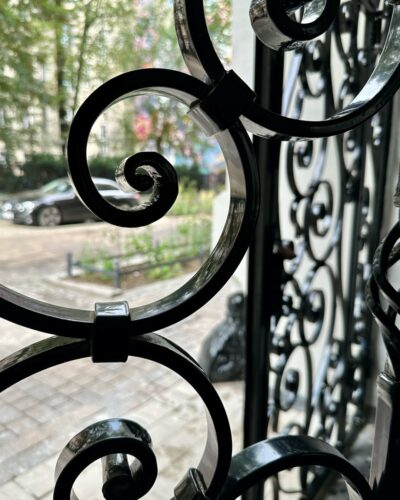
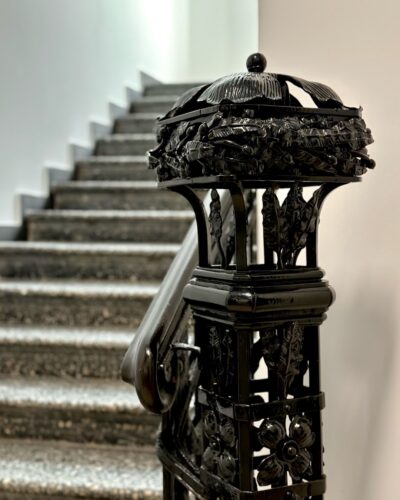

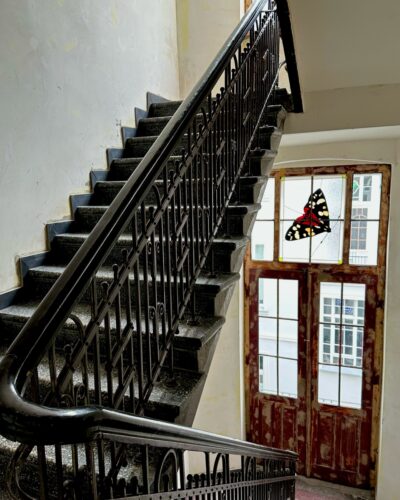



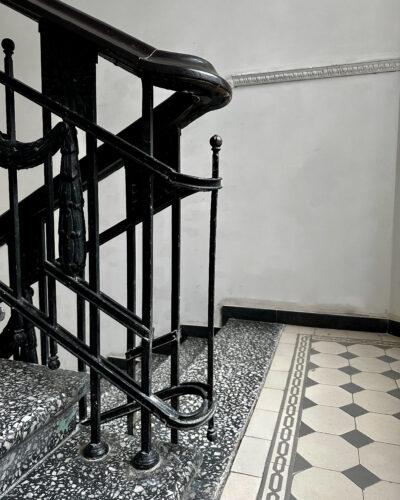





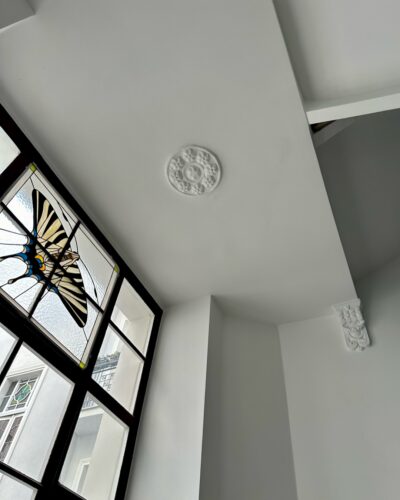
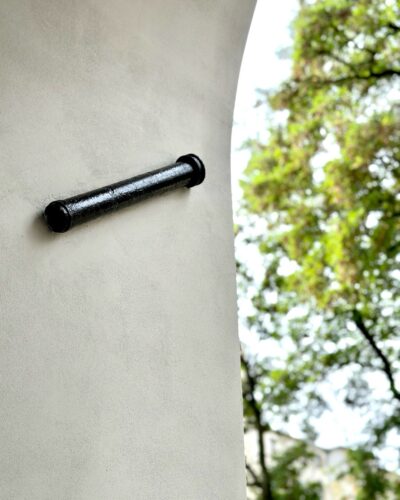
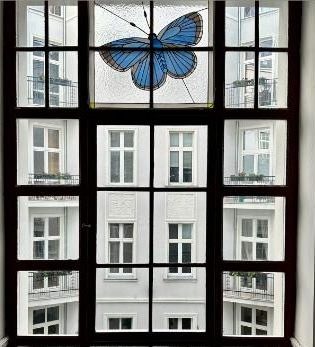

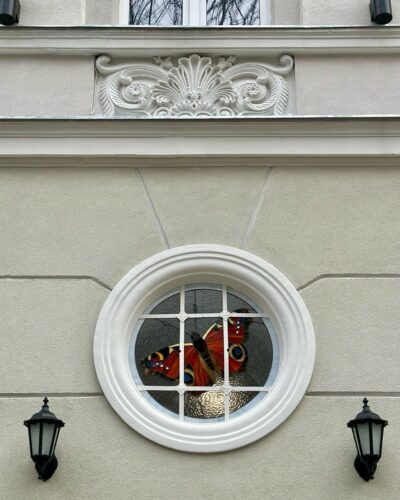
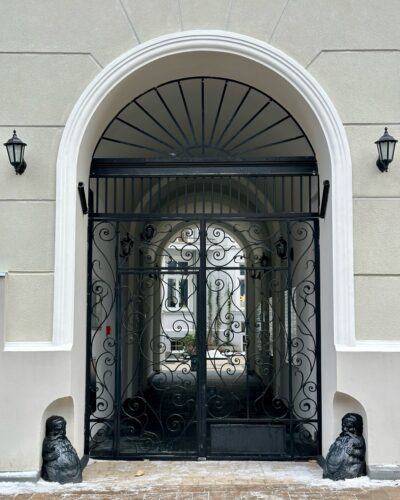



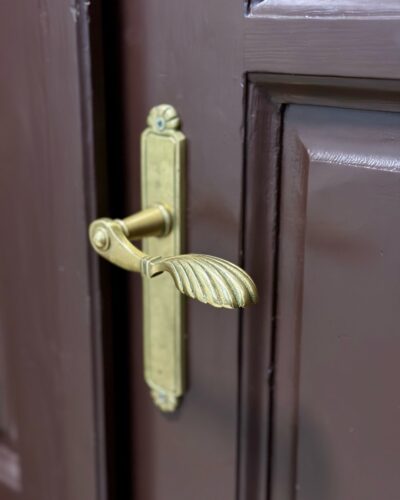



















































Revitalization of a tenement house

PURCHASE OF THE TENEMENT
AND COMMENCEMENT OF WORKS
The townhouse was purchased from a private owner by the Odnova Fund in May 2021. The revitalization work almost took off and was completed in the summer of 2023. The outbreak of war in Ukraine slowed the pace of work somewhat.

Scope of revaluation work
As part of the comprehensive revitalization works carried out in the building, all facades were renovated and illuminated. We have redone all installations, connected the tenement to the municipal heat network, and insulated the roof. The common parts of the property have been completely renovated, and in order to preserve the old atmosphere, very much sought after by investors and tenants, we have carefully restored each of the preserved original details.

APARTMENTS FOR RENT
The tenement houses a number of relatively small apartments, the vast majority of which have been purchased by clients seeking property for investment purposes. Odnova targets such offerings. The satisfaction of our customers is so high that a very small number of apartments are resold again.

The end result
After two years of full involvement of dozens of people of all specialties and skills, we managed to create a project that is one of the showpieces of Lodz. We invite you to see for yourself what the results of our work are. The name "Hidden Garden" for our aparthotel was not chosen at random - the charm of the tenement can only be appreciated by watching it live.

